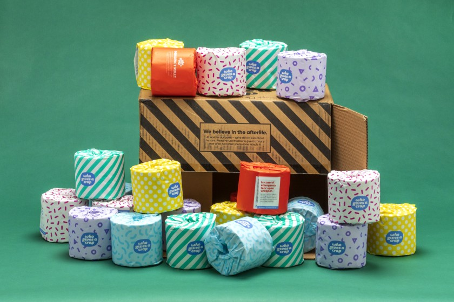Want To Make A Great First Impression? Start At Your Customer's Front Door
Relevant topics Archive, Strategy
Do you ever think about the first impression you leave on others?
If you are like most people, you do. After all, we only have one chance to make a great first impression, right?
But leaving a memorable first impression is not just relevant for people. It’s also very important for online retail brands. In fact, leaving a positive first impression elevates returns, sales, and brand experiences!
Curious to find out how? This blog will explain how brands can use their product delivery packaging to leave an exceptional first impression on their customers.
Brand experiences on customers’ doorsteps
When customers order a product online, their first physical interaction with the brand takes place during product delivery. This is the right time to impress.
But how do you make a long-lasting, astonishing first impression? Well, think about it: the product’s delivery package is the first thing customers perceive and the first thing customers relate to the brand. Well-considered product packaging is key to making a great first impression.
If online retail brands want to create a favorable brand experience right away, they should design a product delivery package that positively stimulates the four different dimensions of brand experience: cognitive, affective, behavioral, and sensory.
The product’s delivery package should be designed in such a way that you can’t get your hands off of it (behavioral). The scents, textures, sounds, and perhaps even tastes you experience during the unboxing experience should fill you with pleasure, joy, excitement or amazement (sensory and affective). And the interesting brand and product information displayed on the box should trigger your mind (cognitive).
An online retail brand that has successfully applied the different dimensions of brand experience to its product packaging design, is Zappos. The #IMNOTABOX Campaign invites customers to get creative with their product’s delivery package and share their results online. The box even contains a llama craft kit. Now, if that does not bring joy, what else will?

Decrease returns, increase sales and build brand equity
Creating a well-designed delivery packaging as described above may cost some blood, sweat, tears, and money. But the benefits that come with it are definitely worth it.
First of all, online shoppers are more likely to keep their delivered product if the unboxing experience gives them a positive feeling, such as pleasure. The use of colorful packaging and inclusion of a small gift, stickers, or gift wrap makes it – thanks to the psychological reciprocity effect – more difficult for customers to return the product.
Delivery packaging also influences consumers’ expectations of what retailers will charge for the product and increases consumers’ willingness to pay. How? Superior delivery packaging serves as a heuristic for quality when products do not have a salient reference price.
In other words, consumers assume that superior delivery packaging equals higher quality and thus, is more expensive. Fortunately for marketers, a product’s delivery package can look of higher quality with just minor, inexpensive changes.
The creative design of delivery packaging also allows online retailers to build or reinforce brand equity. The different elements of delivery packaging (i.e. its exterior, filling material, wrapping material, internal package, and additional contents) can be altered endlessly to highlight brand equity.
For example, sustainable brands can create a brand-consistent experience by using eco-friendly packaging and recyclable filling materials to reinforce the brand’s green message. The brand Who Gives A Crap, which sells recycled toilet paper rolls, does so by using a recyclable cardboard delivery box with the text “We believe in the afterlife”.

Excited about the branding benefits of delivery packaging? Great! But do take the following into account…
Brand stores vs. mass merchandisers
Are you a brand store or a mass merchandiser?
I ask you this question because research shows that people are more likely to think that a superior package was shipped from a brand store compared to a standard package. However, people are not more likely to think that a superior package was shipped from a mass merchandiser compared to a standard package.
A possible explanation is that people expect brand stores to invest in well-considered product delivery packaging, but do not have these expectations for mass merchandisers. This means that mass merchandisers would benefit less from investments in product delivery packaging than brand stores.
Luxurious delivery packaging
Do you want to make your product look premium by using a luxurious delivery package?
Consider that luxurious delivery packaging will only signal quality when the product does not have a salient reference price. If customers know the reference price is low, a luxurious delivery package will probably not result in higher perceived product value.
Delivering a low-quality product in a luxurious product delivery package could even backfire! Imagine you bought a pair of shoes online. The shoes just got delivered to you in a very luxurious product delivery package. Exciting! You immediately open the box, grab the shoes that are inside, and… oh... what a disappointment.
In short, a superior delivery package induces high expectations of the shipped product. If the product quality does not match the quality of the delivery package, this can result in product dissatisfaction.
Remember: you can only make a first impression once
To summarize: instead of focusing solely on the functional aspects of a product’s delivery package, think about its cognitive, behavioral, sensory, and affective impact on the customer. Make sure you’ll create an unforgettable impression right on the customer’s doorsteps!
Take-home messages
- Impact returns, sales, and brand experiences by designing a product delivery package that positively stimulates the four different dimensions of brand experience: cognitive, affective, behavioral, and sensory.
- Be congruent. Use a product’s delivery package to create a brand-consistent experience and match the delivery packaging to the quality of the product.
- Investments in a product’s delivery package are especially profitable for brand stores (vs. mass merchandisers).
Further Reading
-
Why We're Blind To Our Best Ideas
Ideas. They are the rocket fuel behind many of life’s best decisions. And some of the worst.
Whether you’re an entrepreneur in search of fruitful business avenues, a storyteller pondering on a thought-provoking new narrative, or just a tourist contemplating what new things to do for holiday. For many of these decisions, we tend to turn inside for answers. In a very real way, we’re internally brainstorming with ourselves, trying to wrap our hands around these pearls of wisdom we call ideas.
Initial ideas differ widely in their vividness and concreteness. We tend to love vivid ideas. The entrepreneur could suddenly connect the dots between a brand-new technology and a target market that has a need that just screams to be met. The writer can conjure entire plotlines out of thin air in a matter of seconds, beginning, middle and end. And the tourist may suddenly decide to go bungee jumping in the crater of a sleeping volcano – I know I did.
But do these sudden crystal-clear notions always provide the best path to go forward? You may be able to think of some of your own initially brilliant ideas that turned out to be lukewarm at best – I know I do.
And what about those other ideas that were not fully crystalized yet, causing you to throw them out of the window? Of course, the million-dollar question is: how many of those prematurely discarded ideas would have turned out to be brilliant?
Countless of studies have been done on how individuals evaluate the creativity of their final ideas. But the psychology behind how we evaluate and build upon the initial figments of those ideas during the creative process itself has rarely been studied.


